engine Lancia Delta 2011 Owner handbook (in English)
[x] Cancel search | Manufacturer: LANCIA, Model Year: 2011, Model line: Delta, Model: Lancia Delta 2011Pages: 290, PDF Size: 8.36 MB
Page 106 of 290
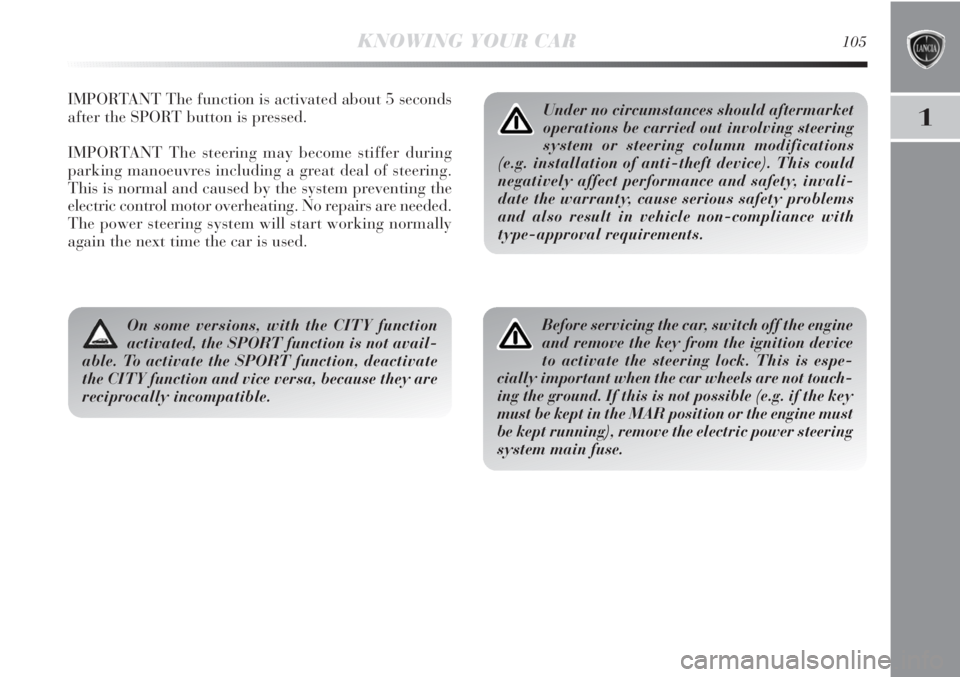
1
KNOWING YOUR CAR105
IMPORTANT The function is activated about 5 seconds
after the SPORT button is pressed.
IMPORTANT The steering may become stiffer during
parking manoeuvres including a great deal of steering.
This is normal and caused by the system preventing the
electric control motor overheating. No repairs are needed.
The power steering system will start working normally
again the next time the car is used.Under no circumstances should aftermarket
operations be carried out involving steering
system or steering column modifications
(e.g. installation of anti-theft device). This could
negatively affect performance and safety, invali-
date the warranty, cause serious safety problems
and also result in vehicle non-compliance with
type-approval requirements.
Before servicing the car, switch off the engine
and remove the key from the ignition device
to activate the steering lock. This is espe-
cially important when the car wheels are not touch-
ing the ground. If this is not possible (e.g. if the key
must be kept in the MAR position or the engine must
be kept running), remove the electric power steering
system main fuse.On some versions, with the CITY function
activated, the SPORT function is not avail-
able. To activate the SPORT function, deactivate
the CITY function and vice versa, because they are
reciprocally incompatible.
Page 108 of 290

1
KNOWING YOUR CAR107
In the 1.4 Turbo Jet 150 HP version, pressing the SPORT
button, the turbocharger supercharging function (over-
boost) starts; considering the
position of the accelerator pedal and for a limited time,
the engine management control unit achieves maximum
pressure levels inside the turbocharger, with a consequent
increase in engine torque with respect to that which is
normally possible.
This function is particularly useful whenever maximum
performance is required for a short time (e.g. when over-
taking).
IMPORTANT During acceleration, when the SPORT
function is used the steering may shudder which is typi-
cal of a sports setting.
IMPORTANT The function is activated about 5 seconds
after the SPORT button is pressed.
System failure
In the event of a malfunction, the system notifies the dri-
ver of the fault via a dedicated message in the reconfig-
urable multifunction display instrument panel and the
amber
isymbol coming on.
In this case, go to a Lancia Dealership.
DRIVING ADVISOR
(Lane crossing warning )
(for versions/markets, where provided)
The Driving Advisor is a warning system that notifies
the driver if he/she crosses the lane because he/she
has been distracted.A video sensor, fitted on the wind-
screen near the interior rear view mirror, detects the lane
demarcation lines and the position of the car in relation
to them.
IMPORTANT If the windscreen needs replacing on cars
fitted with a Driving Advisor system, it is advisable to go
to a Lancia Dealership. If the repair is being carried out
at a specialist window replacement centre, it is still nec-
essary to go to a Lancia Dealership to have the TV cam-
era calibrated.
Page 113 of 290
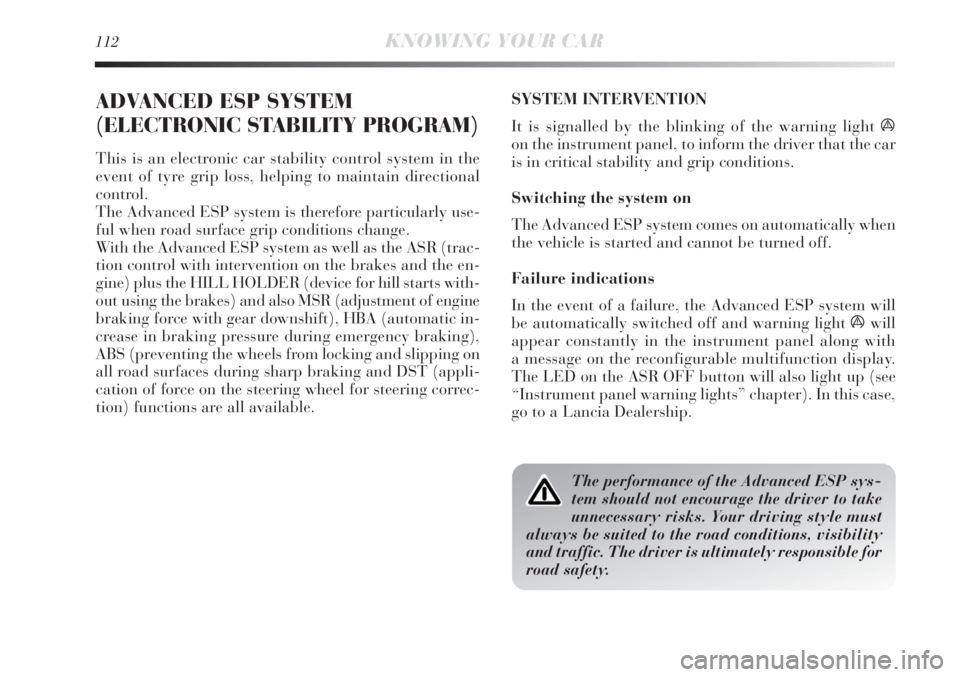
112KNOWING YOUR CAR
ADVANCED ESP SYSTEM
(ELECTRONIC STABILITY PROGRAM)
This is an electronic car stability control system in the
event of tyre grip loss, helping to maintain directional
control.
The Advanced ESP system is therefore particularly use-
ful when road surface grip conditions change.
With the Advanced ESP system as well as the ASR (trac-
tion control with intervention on the brakes and the en-
gine) plus the HILL HOLDER (device for hill starts with-
out using the brakes) and also MSR (adjustment of engine
braking force with gear downshift), HBA (automatic in-
crease in braking pressure during emergency braking),
ABS (preventing the wheels from locking and slipping on
all road surfaces during sharp braking and DST (appli-
cation of force on the steering wheel for steering correc-
tion) functions are all available. SYSTEM INTERVENTION
It is signalled by the blinking of the warning light á
on the instrument panel, to inform the driver that the car
is in critical stability and grip conditions.
Switching the system on
The Advanced ESP system comes on automatically when
the vehicle is started and cannot be turned off.
Failure indications
In the event of a failure, the Advanced ESP system will
be automatically switched off and warning light áwill
appear constantly in the instrument panel along with
a message on the reconfigurable multifunction display.
The LED on the ASR OFF button will also light up (see
“Instrument panel warning lights” chapter). In this case,
go to a Lancia Dealership.
The performance of the Advanced ESP sys-
tem should not encourage the driver to take
unnecessary risks. Your driving style must
always be suited to the road conditions, visibility
and traffic. The driver is ultimately responsible for
road safety.
Page 114 of 290
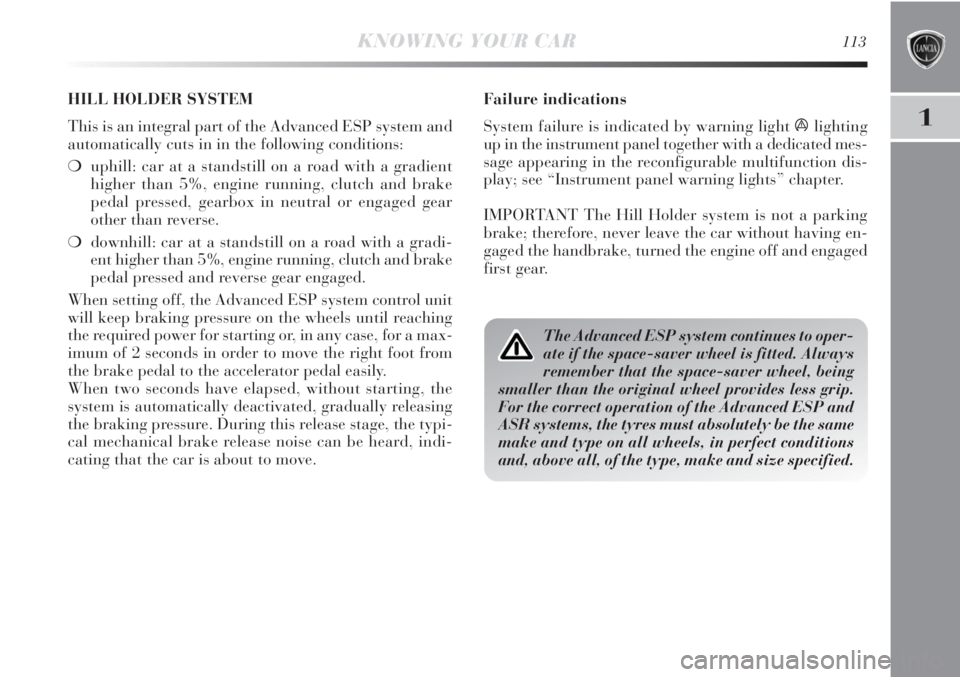
1
KNOWING YOUR CAR113
Failure indications
System failure is indicated by warning light
álighting
up in the instrument panel together with a dedicated mes-
sage appearing in the reconfigurable multifunction dis-
play; see “Instrument panel warning lights” chapter.
IMPORTANT The Hill Holder system is not a parking
brake; therefore, never leave the car without having en-
gaged the handbrake, turned the engine off and engaged
first gear.
The Advanced ESP system continues to oper-
ate if the space-saver wheel is fitted. Always
remember that the space-saver wheel, being
smaller than the original wheel provides less grip.
For the correct operation of the Advanced ESP and
ASR systems, the tyres must absolutely be the same
make and type on all wheels, in perfect conditions
and, above all, of the type, make and size specified.
HILL HOLDER SYSTEM
This is an integral part of the Advanced ESP system and
automatically cuts in in the following conditions:
❍uphill: car at a standstill on a road with a gradient
higher than 5%, engine running, clutch and brake
pedal pressed, gearbox in neutral or engaged gear
other than reverse.
❍downhill: car at a standstill on a road with a gradi-
ent higher than 5%, engine running, clutch and brake
pedal pressed and reverse gear engaged.
When setting off, the Advanced ESP system control unit
will keep braking pressure on the wheels until reaching
the required power for starting or, in any case, for a max-
imum of 2 seconds in order to move the right foot from
the brake pedal to the accelerator pedal easily.
When two seconds have elapsed, without starting, the
system is automatically deactivated, gradually releasing
the braking pressure. During this release stage, the typi-
cal mechanical brake release noise can be heard, indi-
cating that the car is about to move.
Page 115 of 290
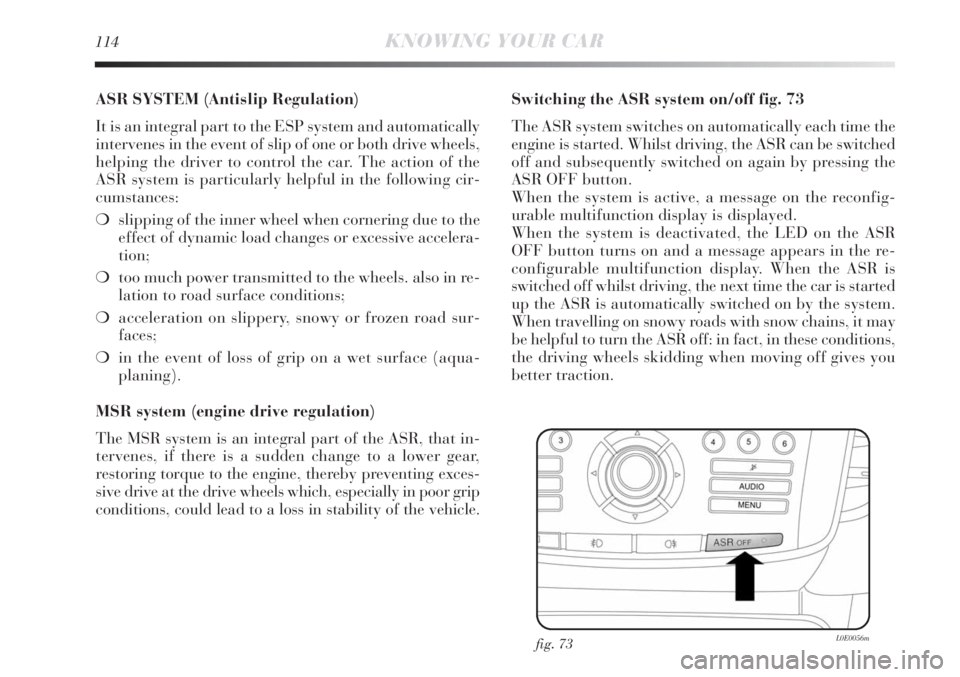
114KNOWING YOUR CAR
ASR SYSTEM (Antislip Regulation)
It is an integral part to the ESP system and automatically
intervenes in the event of slip of one or both drive wheels,
helping the driver to control the car. The action of the
ASR system is particularly helpful in the following cir-
cumstances:
❍slipping of the inner wheel when cornering due to the
effect of dynamic load changes or excessive accelera-
tion;
❍too much power transmitted to the wheels. also in re-
lation to road surface conditions;
❍acceleration on slippery, snowy or frozen road sur-
faces;
❍in the event of loss of grip on a wet surface (aqua-
planing).
MSR system (engine drive regulation)
The MSR system is an integral part of the ASR, that in-
tervenes, if there is a sudden change to a lower gear,
restoring torque to the engine, thereby preventing exces-
sive drive at the drive wheels which, especially in poor grip
conditions, could lead to a loss in stability of the vehicle.Switching the ASR system on/off fig. 73
The ASR system switches on automatically each time the
engine is started. Whilst driving, the ASR can be switched
off and subsequently switched on again by pressing the
ASR OFF button.
When the system is active, a message on the reconfig-
urable multifunction display is displayed.
When the system is deactivated, the LED on the ASR
OFF button turns on and a message appears in the re-
configurable multifunction display. When the ASR is
switched off whilst driving, the next time the car is started
up the ASR is automatically switched on by the system.
When travelling on snowy roads with snow chains, it may
be helpful to turn the ASR off: in fact, in these conditions,
the driving wheels skidding when moving off gives you
better traction.
fig. 73L0E0056m
Page 118 of 290
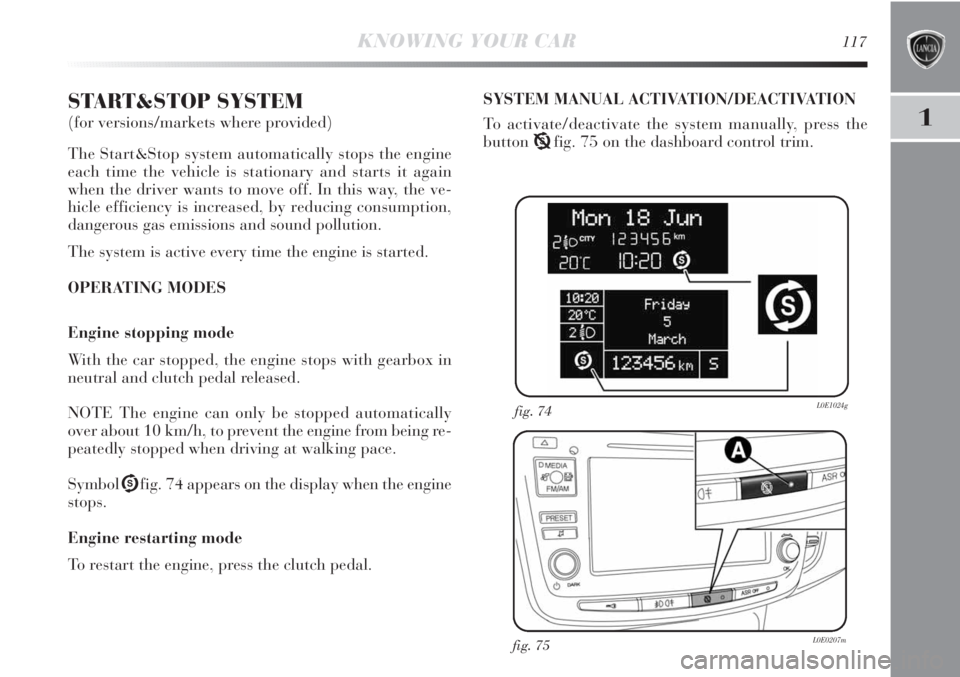
1
KNOWING YOUR CAR117
START&STOP SYSTEM
(for versions/markets where provided)
The Start&Stop system automatically stops the engine
each time the vehicle is stationary and starts it again
when the driver wants to move off. In this way, the ve-
hicle efficiency is increased, by reducing consumption,
dangerous gas emissions and sound pollution.
The system is active every time the engine is started.
OPERATING MODES
Engine stopping mode
With the car stopped, the engine stops with gearbox in
neutral and clutch pedal released.
NOTE The engine can only be stopped automatically
over about 10 km/h, to prevent the engine from being re-
peatedly stopped when driving at walking pace.
SymbolUfig. 74 appears on the display when the engine
stops.
Engine restarting mode
To restart the engine, press the clutch pedal.SYSTEM MANUAL ACTIVATION/DEACTIVATION
To activate/deactivate the system manually, press the
buttonTfig. 75 on the dashboard control trim.
fig. 74L0E1024g
fig. 75L0E0207m
Page 119 of 290
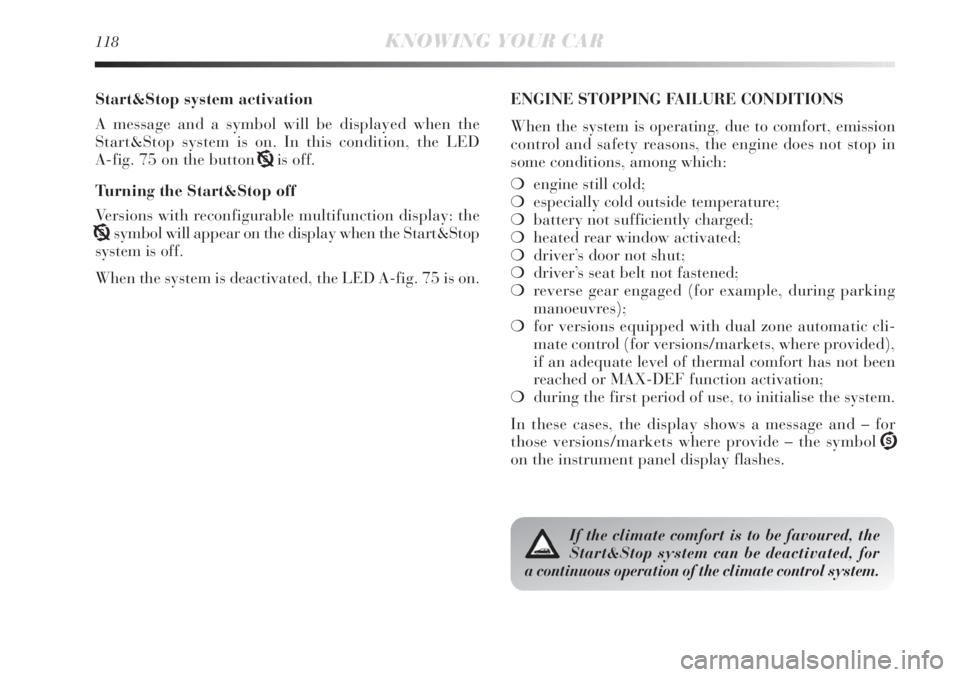
118KNOWING YOUR CAR
Start&Stop system activation
A message and a symbol will be displayed when the
Start&Stop system is on. In this condition, the LED
A-fig. 75 on the button Tis off.
Turning the Start&Stop off
Versions with reconfigurable multifunction display: the
Tsymbol will appear on the display when the Start&Stop
system is off.
When the system is deactivated, the LED A-fig. 75 is on.ENGINE STOPPING FAILURE CONDITIONS
When the system is operating, due to comfort, emission
control and safety reasons, the engine does not stop in
some conditions, among which:
❍engine still cold;
❍especially cold outside temperature;
❍battery not sufficiently charged;
❍heated rear window activated;
❍driver’s door not shut;
❍driver’s seat belt not fastened;
❍reverse gear engaged (for example, during parking
manoeuvres);
❍for versions equipped with dual zone automatic cli-
mate control (for versions/markets, where provided),
if an adequate level of thermal comfort has not been
reached or MAX-DEF function activation;
❍during the first period of use, to initialise the system.
In these cases, the display shows a message and – for
those versions/markets where provide – the symbol U
on the instrument panel display flashes.
If the climate comfort is to be favoured, the
Start&Stop system can be deactivated, for
a continuous operation of the climate control system.
Page 120 of 290
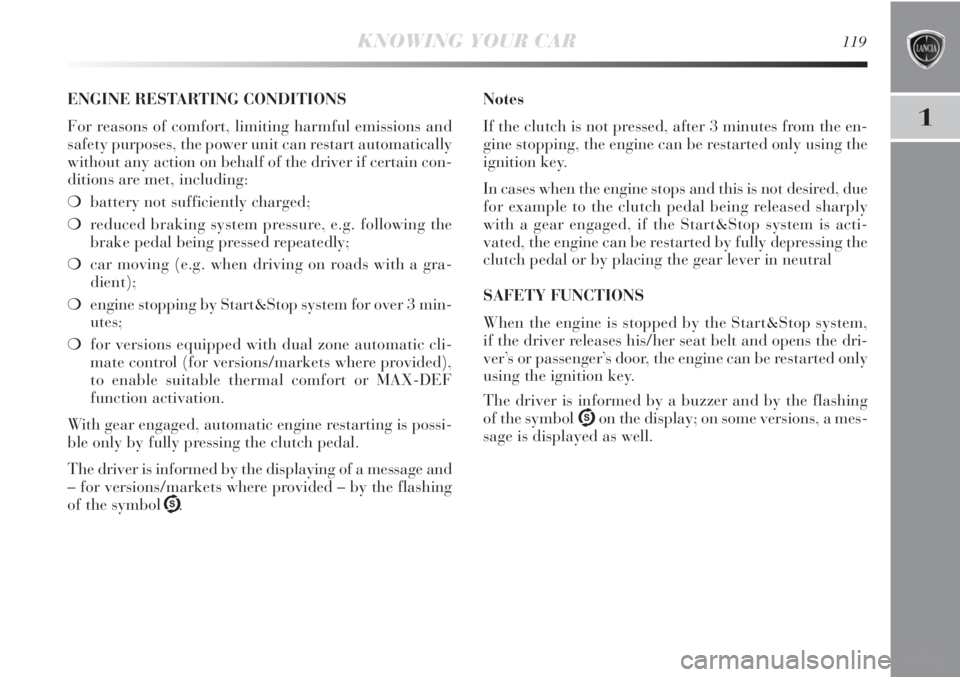
1
KNOWING YOUR CAR119
ENGINE RESTARTING CONDITIONS
For reasons of comfort, limiting harmful emissions and
safety purposes, the power unit can restart automatically
without any action on behalf of the driver if certain con-
ditions are met, including:
❍battery not sufficiently charged;
❍reduced braking system pressure, e.g. following the
brake pedal being pressed repeatedly;
❍car moving (e.g. when driving on roads with a gra-
dient);
❍engine stopping by Start&Stop system for over 3 min-
utes;
❍for versions equipped with dual zone automatic cli-
mate control (for versions/markets where provided),
to enable suitable thermal comfort or MAX-DEF
function activation.
With gear engaged, automatic engine restarting is possi-
ble only by fully pressing the clutch pedal.
The driver is informed by the displaying of a message and
– for versions/markets where provided – by the flashing
of the symbol U.Notes
If the clutch is not pressed, after 3 minutes from the en-
gine stopping, the engine can be restarted only using the
ignition key.
In cases when the engine stops and this is not desired, due
for example to the clutch pedal being released sharply
with a gear engaged, if the Start&Stop system is acti-
vated, the engine can be restarted by fully depressing the
clutch pedal or by placing the gear lever in neutral
SAFETY FUNCTIONS
When the engine is stopped by the Start&Stop system,
if the driver releases his/her seat belt and opens the dri-
ver’s or passenger’s door, the engine can be restarted only
using the ignition key.
The driver is informed by a buzzer and by the flashing
of the symbol Uon the display; on some versions, a mes-
sage is displayed as well.
Page 121 of 290

120KNOWING YOUR CAR
ENERGY SAVING FUNCTION
(for versions/markets where provided)
If, as a result of the automatic engine restarting, the dri-
ver does not carry out any action on the vehicle for over
3 minutes, the Start&Stop system stops the engine once
and for all, to prevent fuel consumption. In these cases,
the engine can be restarted only by using the ignition key.
NOTE In any case, it is possible to keep the engine run-
ning by deactivating the Start&Stop system.
OPERATING IRREGULARITIES
In the event of malfunction, the Start&Stop system is de-
activated. The driver is informed about the failure
through the switching-on of the symbol Uon the in-
strument panel and – for some versions – through the
displaying of a message. In this case, go to a Lancia
Dealership.CAR INACTIVITY
In cases of car inactivity, special attention must be paid
due to the disconnection of the battery power supply.
Proceed as follows: detach the connector A-fig. 76 (by
pressing button B) from sensor C for monitoring the sta-
tus of the battery installed on the negative battery pole
D. This sensor should never be disconnected from the
pole except if the battery is replaced.
fig. 76L0E0191m
When replacing the battery, always contact
a Lancia Dealership. Replace the battery
using a new one of the same type (HEAVY
DUTY) and with the same specifications.
Page 122 of 290
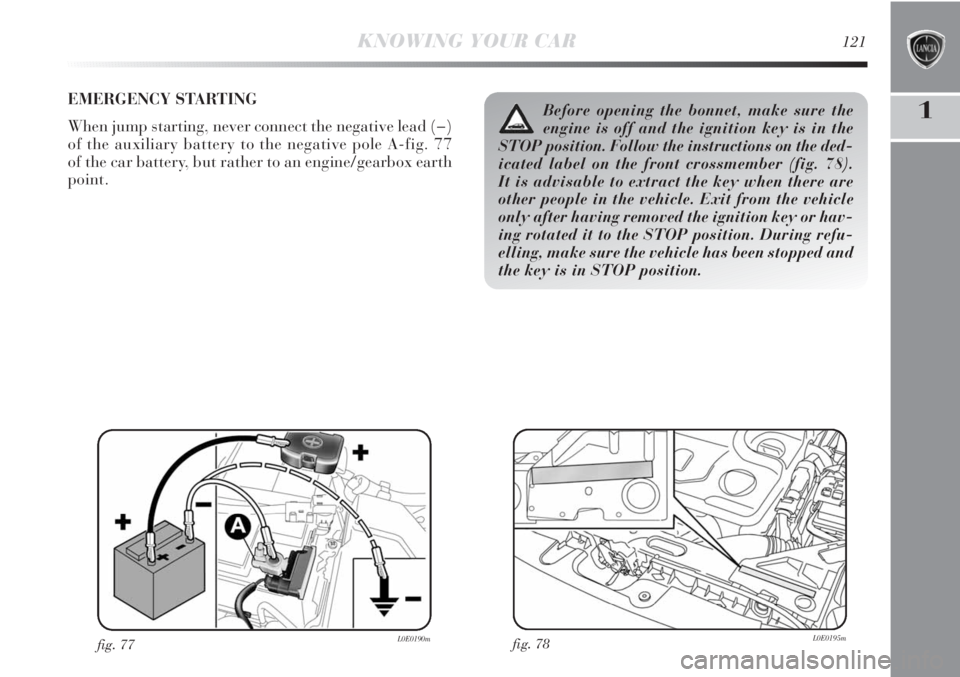
1
KNOWING YOUR CAR121
EMERGENCY STARTING
When jump starting, never connect the negative lead (−)
of the auxiliary battery to the negative pole A-fig. 77
of the car battery, but rather to an engine/gearbox earth
point.
fig. 77L0E0190mfig. 78L0E0195m
Before opening the bonnet, make sure the
engine is off and the ignition key is in the
STOP position. Follow the instructions on the ded-
icated label on the front crossmember (fig. 78).
It is advisable to extract the key when there are
other people in the vehicle. Exit from the vehicle
only after having removed the ignition key or hav-
ing rotated it to the STOP position. During refu-
elling, make sure the vehicle has been stopped and
the key is in STOP position.